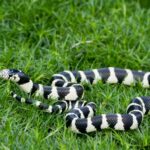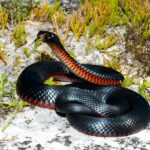Green snakes, nature’s verdant marvels, are as diverse as they are captivating. These serpents, adorned in various shades of green, inhabit different corners of the world, from dense forests to arid deserts.
In this article, we’ll uncover the unique traits of 11 green snake species, focusing on their lengths, habitats, venomous characteristics, colors, and geographical locations.
Quick Overview
| Species Name | Length | Venomous | Location |
|---|---|---|---|
| Rough Green Snake | Up to 32 inches | No | Eastern United States |
| Smooth Green Snake | 14 to 20 inches | No | Northeastern, Midwestern U.S. |
| Green Tree Python | Up to 7 feet | No | New Guinea, Australia |
| Boomslang | Up to 5 feet | Yes | Sub-Saharan Africa |
| Eastern Green Mamba | Up to 6 feet | Yes | Eastern Africa |
| Western Green Mamba | Up to 7 feet | Yes | West Africa |
| Red-tailed Green Ratsnake | Up to 8 feet | No | Southeast Asia, Philippines |
| Green Anaconda | Up to 30 feet | No | South America |
| African Bush Viper | 18 to 24 inches | Yes | Sub-Saharan Africa |
| Green Pit Viper | 2 to 3 feet | Yes | Southeast Asia |
| Vine Snake | Up to 6 feet | No | South, Southeast Asia |
1. Rough Green Snake
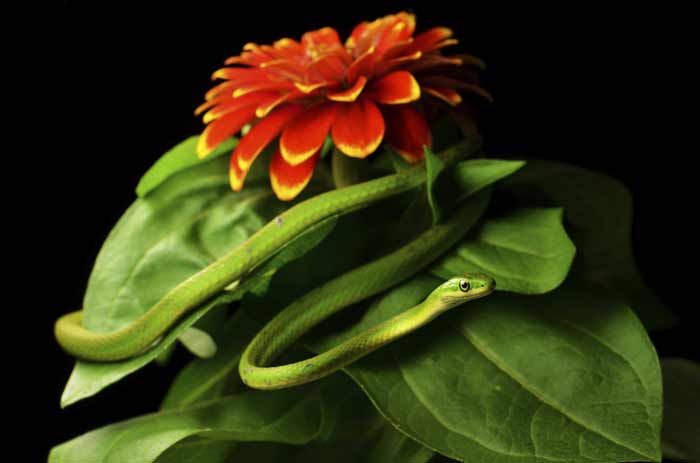
The Rough Green Snake (Opheodrys aestivus), thriving in the eastern United States, is a slender, non-venomous serpent, growing up to 32 inches.
Its bright green coloration provides perfect camouflage among the leaves and branches of its wooded and bushy habitats.
This gentle snake primarily feeds on insects and spiders, making it a natural pest controller. It’s often found in gardens and parks, where it can be seen gracefully navigating through vegetation.
2. Smooth Green Snake

The Smooth Green Snake (Opheodrys vernalis), native to the northeastern and midwestern U.S., is a small, non-venomous species, reaching about 14 to 20 inches in length.
It sports a uniform, smooth, and bright green coloration, with a pale yellow or white belly. Preferring open meadows, near streams, and lightly wooded areas, this snake feeds mainly on insects, particularly crickets and grasshoppers.
Despite its small size, the Smooth Green Snake plays a significant role in controlling insect populations in its ecosystem.
3. Green Tree Python

Native to New Guinea and parts of Australia, the Green Tree Python (Morelia viridis) is a striking species known for its vibrant green color and a distinctive pattern of white or yellow scales.
This non-venomous python can grow up to 7 feet in length and is primarily found in tropical rainforests. It’s an arboreal snake, spending most of its life in trees, where it hunts small mammals and birds.
The Green Tree Python is popular in the pet trade due to its beautiful coloration and unique coiling behavior.
4. Boomslang
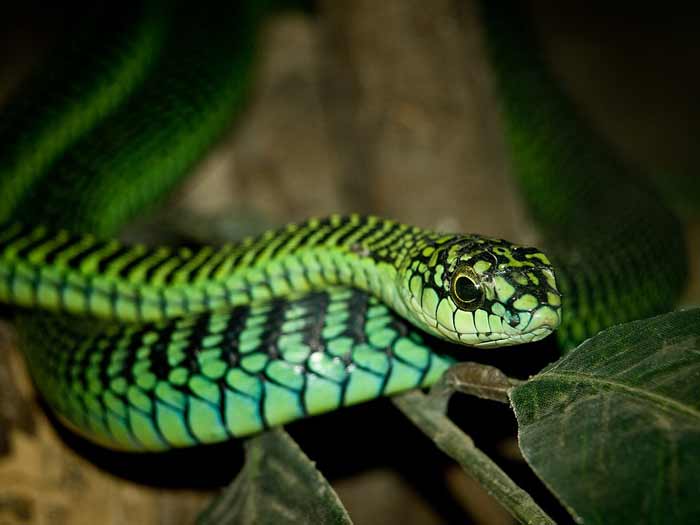
The Boomslang (Dispholidus typus), residing in sub-Saharan Africa, is a highly venomous snake known for its striking green color, which can vary from light to dark shades.
It can reach lengths of up to 5 feet and is predominantly found in forests and savannas. The Boomslang is a tree-dwelling snake, feeding mainly on birds and their eggs.
Its venom is hemotoxic, causing severe bleeding in victims, but it is generally shy and avoids human contact.
5. Eastern Green Mamba

Another African species, the Eastern Green Mamba (Dendroaspis angusticeps), is known for its bright green color and potent venom. Growing up to 6 feet, it resides in coastal forests of eastern Africa.
This venomous snake is primarily arboreal and preys on birds and small mammals. The Eastern Green Mamba is fast and agile, both in trees and on the ground, and its venom can be life-threatening to humans without prompt medical treatment.
6. Western Green Mamba

The Western Green Mamba (Dendroaspis viridis), found in West Africa, is a close relative of the Eastern Green Mamba. This venomous snake can grow up to 7 feet and has a slender body with a bright green color.
It inhabits coastal rainforests and woodland areas, where it hunts for birds, bats, and rodents. The Western Green Mamba is known for its nervous temperament and potent venom, which can be fatal if not treated promptly.
7. Philippine Green Tree Snake

The Red-tailed Green Ratsnake (Gonyosoma oxycephalum) is found in Southeast Asia, particularly in the Philippines.
This non-venomous snake can reach lengths of up to 8 feet and is characterized by its bright green color with a reddish tail.
It’s an arboreal species, living in tropical rainforests and feeding on birds, bats, and small mammals. The Philippine Green Tree Snake is known for its agility and speed in the trees.
8. Green Anaconda

The Green Anaconda (Eunectes murinus), one of the world’s largest snakes, is found in South America, particularly in the Amazon Basin.
This non-venomous snake can grow to an astounding length of up to 30 feet and weigh over 200 pounds. It has a dark green color with black spots and is primarily found in swamps, marshes, and slow-moving rivers.
The Green Anaconda is an aquatic snake, adept at swimming and hunting in water, where it preys on a variety of animals, including fish, birds, and even large mammals.
9. African Bush Viper
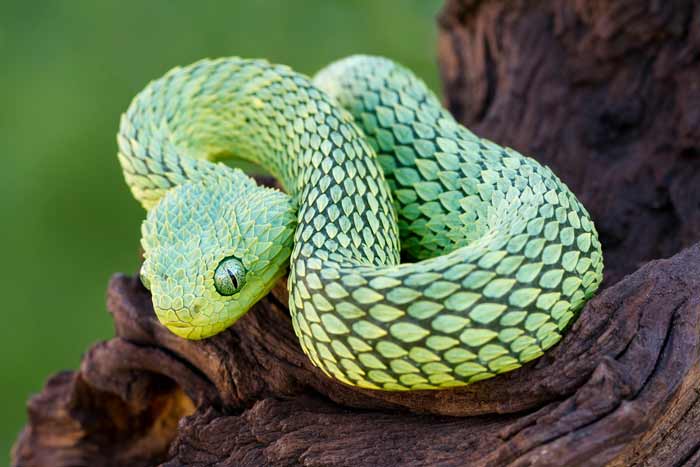
The African Bush Viper (Atheris squamigera), native to sub-Saharan Africa, is a small but highly venomous snake, growing to about 18 to 24 inches. It has a striking green color, often with yellow or blue tinges, and is known for its keeled scales, giving it a bristly appearance.
This snake inhabits tropical rainforests and is arboreal, hunting for small mammals, birds, and lizards. The venom of the African Bush Viper is hemotoxic, causing tissue damage and bleeding.
10. Green Pit Viper
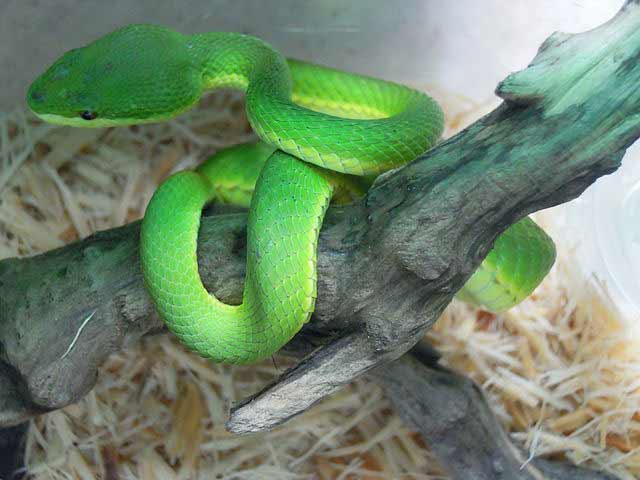
The Green Pit Vipers (Trimeresurus spp.) are a group of venomous snakes found throughout Southeast Asia. They vary in size, typically ranging from 2 to 3 feet in length, and are known for their bright green color, sometimes with yellow or red markings.
These snakes inhabit forests and plantations, where they hunt for small mammals, birds, and frogs. Green Pit Vipers are arboreal and have heat-sensing pits, which they use to detect warm-blooded prey.
11. Vine Snake
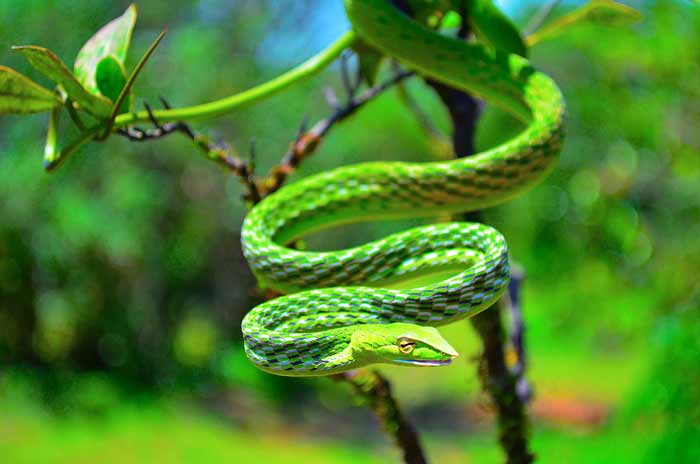
The Vine Snake (Ahaetulla nasuta), found in South and Southeast Asia, is a slender, non-venomous snake that can grow up to 6 feet. It has a bright green color, which helps it blend into its forest and jungle habitats.
This snake is arboreal and feeds primarily on lizards and frogs. The Vine Snake is known for its unique ability to change color slightly, depending on its surroundings, and for its horizontal pupil, which gives it a distinctive appearance.
Conclusion
Green snakes, from the massive Green Anaconda to the slender Vine Snake, showcase the incredible diversity and adaptability of these reptiles. Their varying shades of green provide camouflage in their natural habitats, aiding in hunting and protection.
These snakes, each with its unique behavior and ecological role, remind us of the importance of biodiversity and the need to preserve their natural habitats for future generations to witness and appreciate.
FAQs
Green snakes are a group of snake species known for their distinctive green coloration. This color can range from bright emerald to darker shades of green.
It varies by species. Some green snakes, like the Eastern Green Mamba and the African Bush Viper, are highly venomous, while others, such as the Rough Green Snake and the Smooth Green Snake, are non-venomous.
Green snakes are found in various parts of the world, including North America, South America, Africa, and Asia. Their habitats range from tropical rainforests and wetlands to arid deserts.
Some non-venomous green snakes, like the Green Tree Python, are popular pets. However, venomous species or those with special care requirements are not suitable for most pet owners.
The green coloration in snakes is primarily for camouflage, allowing them to blend into foliage and trees in their natural habitats. This coloration is an evolutionary adaptation to their environments.

